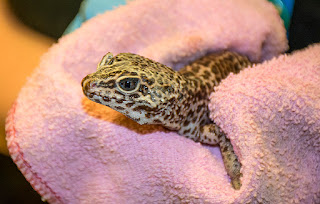When an animal doesn’t eat one time, it rarely is a cause for concern. Maybe they aren’t hungry, or pre-occupied with shedding their skin. But when it becomes a trend then we need to get to the bottom of it. Careful record keeping is necessary to spot these trends and Animal Caretakers recently saw one that clearly required medical attention with Lydia, our nearly 20-year-old leopard gecko.
Lydia loves eating mealworms. She gets 3 juicy mealworms every other day and we always log her appetite after the feeding. When she started skipping multiple meals, we got concerned. We’ve talked with our vet in the past about this behavior, and he’s always been more concerned with her weight than her appetite. She self-regulates to a degree, but this time her weight was starting to drop too. We also noticed some other strange behaviors from Lydia. Her feces were suddenly very large, sandy looking, and had a clear greenish tint. She was moving around a lot more and not sleeping in her usual locations. And Lydia was even observed to be eating sand. All these warning signs together meant that it was time to bring in Dr. Maas.
One of the trickiest things with treating animal health issues is the problem of stress. A vet visit is clearly stressful to an animal that doesn’t understand what is going on and is suddenly getting poked and prodded. Dr. Maas took both a fecal and blood sample during his visit. Lydia responded by shedding her skin, a normal behavior, but also indicative of her high stress levels. Her fecal sample showed that she was parasite free, but the green tinge meant that there was bile in it. There were problems with her GI tract.
Dr. Maas prescribed both an oral antibiotic, Flagyl®, and one administered subcutaneously for Lydia. She was most likely deficient in calcium, and eating the sand because it contained that mineral. Lydia has always eaten mealworms. We began to raise the mealworms with better quality feed and added calcium supplements. Indirectly, by feeding these nutrients to the mealworms we were giving them to the leopard gecko too. And to help out with Lydia's shedding issues, Dr. Maas prescribed lukewarm baths.
When you start medicating a sick animal, it is tough to believe that you’re actually helping it. Lydia seemed so miserable with her oral meds and her injections that we had to remind ourselves that ultimately her added stress was going to be worth it. She shed again in short succession and didn’t eat much of this or her last shed.
Eventually, we started to see improvements. While Lydia’s weight had dropped significantly (likely from all that uneaten shed), her appetite has returned. She is now eating her full amount of food plus a little extra to help her put on weight. Her movement and body positions have returned to what we’re used to seeing of her. Her feces have lost their green tinge.
Lydia is all done with her medication now, which likely means her stress levels have also dropped down. So while we will continue to give her baths, feed her mealworms a high calcium diet, and monitor her closely, we’re very optimistic about her making a full recovery. Come check her out and see her tail get more and more plump!
Tuesday, July 14, 2015
Subscribe to:
Post Comments (Atom)







No comments:
Post a Comment